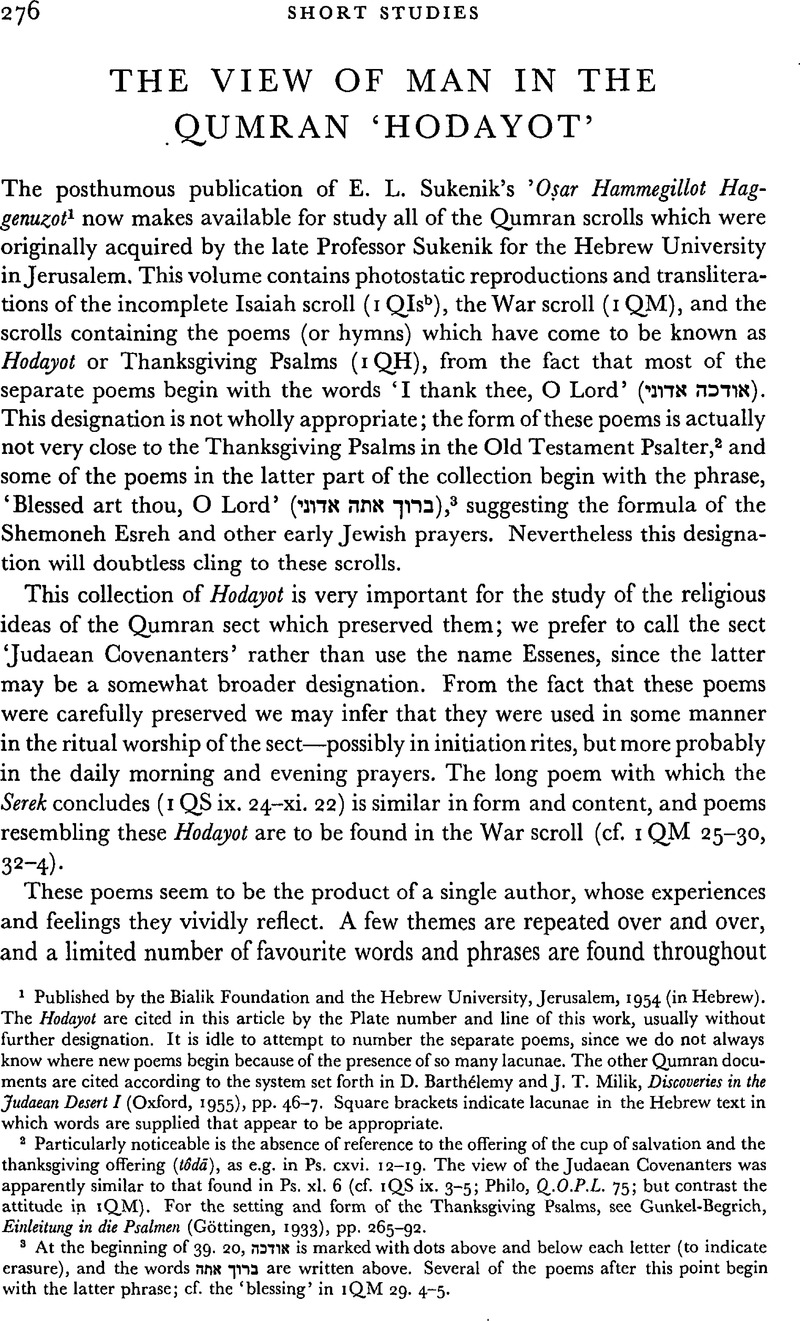Published online by Cambridge University Press: 05 February 2009

page 276 note 1 Published by the Bialik Foundation and the Hebrew University, Jerusalem, 1954 (in Hebrew). The Hodayot are cited in this article by the Plate number and line of this work, usually without further designation. It is idle to attempt to number the separate poems, since we do not always know where new poems begin because of the presence of so many lacunae. The other Qumran documents are cited according to the system set forth in D. Barthélemy and J. T. Milik, Discoveries in the Judaean Desert I (Oxford, 1955), pp. 46–7. Square brackets indicate lacunae in the Hebrew text in which words are supplied that appear to be appropriate.
page 276 note 2 Particularly noticeable is the absence of reference to the offering of the cup of salvation and the thanksgiving offering (tôdā), as e.g. in Ps. cxvi. 12–19. The view of the Judaean Covenanters was apparently similar to that found in Ps. xl. 6 (cf. IQS ix. 3–5; Philo, Q.O.P.L. 75; but contrast the attitude in IQM). For the setting and form of the Thanksgiving Psalms, see Gunkel-Begrich, Einleitung in die Psalmen (Göttingen, 1933), pp. 265–92.
page 276 note 3 At the beginning of 39. 20, ![]() is marked with dots above and below each letter (to indicate erasure), and the words
is marked with dots above and below each letter (to indicate erasure), and the words ![]() are written above. Several of the poems after this point begin with the latter phrase; cf. the ‘blessing’ in IQM 29. 4–5.
are written above. Several of the poems after this point begin with the latter phrase; cf. the ‘blessing’ in IQM 29. 4–5.
page 277 note 1 Glanzman, George S., Theological Studies, vol. XIII (1952), p. 490; Sukenik, op. cit. p. 34; and others.Google Scholar
page 277 note 2 The title Moreh Sedeq could mean either (1) righteous teacher, or (2) teacher of righteousness. In the latter case righteousness could mean either (a) moral uprightness, standards of conduct, and the like; or (b) deliverance, salvation, etc. as in Isa. xlvi. 13; li. 1, 5, 6, 8 and other Old Testament passages. In view of the general tenor of Qumran theology and its literature, it seems probable that the last-named interpretation is correct. The Moreh Sedeq taught his followers and pupils the way of salvation and redemption. For this meaning of sedeq see especially K. Hj. Fahlgren, S daka, nahestehende u. entgegengesetzte Begriffe im Alten Testament (Uppsala, 1932), pp. 97–106.
page 277 note 3 This word, which occurs frequently in the Serek, apparently was the name given to the full members of the sect, possibly the lay members as opposed to the priestly. It seems more likely that the meaning was ‘the great ones’ or the like, rather than ‘the many’ as usually rendered.
page 277 note 4 This text is in Barthélemy and Milik, op. cit. p. 78.
page 278 note 1 ![]() here may stand for
here may stand for ![]() and mean ‘foundation’, as in 40.26; 41.9; cf.
and mean ‘foundation’, as in 40.26; 41.9; cf. ![]() in Job xl. 20; Isa. xliv. 19, for
in Job xl. 20; Isa. xliv. 19, for ![]() . The word is read
. The word is read ![]() and rendered ‘filth’ by Yadin, J.B.L., vol. LXXIV (1955), p. 42.
and rendered ‘filth’ by Yadin, J.B.L., vol. LXXIV (1955), p. 42. ![]() and
and ![]() are often indistinguishable in the Hodayot.Google Scholar
are often indistinguishable in the Hodayot.Google Scholar
page 278 note 2 For the meaning of ![]() , see Yadin, ibid.
, see Yadin, ibid.
page 280 note 1 Cf IQS iii. 15, which declares that before things came into existence, God established their plan or design (![]() ); cf. also the idea, expressed in Bereshit Rabba on Gen. i. I, that God created first of all the torah as the plan by which the world was created.
); cf. also the idea, expressed in Bereshit Rabba on Gen. i. I, that God created first of all the torah as the plan by which the world was created.
page 280 note 2 Cf. Porter, F. C, ‘The Yeçer Hara. A Study in the Jewish Doctrine of Sin’, in Biblical and Semitic Studies (New York and London, 1901); George Foot Moore, Judaism, vol. I (Cambridge, 1927), pp. 479–93; and Samuel S. Cohon, ‘Original Sin’, H.U.C.A., vol. XXI (1948), pp. 275–330.Google Scholar
page 280 note 3 Cf. the Syriac of Sirach xxi. II. Does not this doctrine underlie Jas. i. 14?
page 281 note 1 Or, act wisely (![]() ).
).
page 281 note 2 Or, act wisely. The text has ![]() , but this apparently is a scribal error for
, but this apparently is a scribal error for ![]() , as Sukenik has noted.
, as Sukenik has noted.
page 281 note 3 Or, is made.
page 282 note 1 Cf. the statement in IQM xxviii, 10–11, that God created Belial.
page 283 note 1 The Judaean Covenanters apparently did not see the contradiction of their determinism which was involved in their insistence that their sect was made up of ‘volunteers’, who chose to apply for membership, and also in the fact that some members could ‘backslide’ and be excommunicated, provisions being made in the Serek for this possibility (IQS vii. 22–5). This only testifies to the virtual impossibility of being either wholly deterministic or wholly voluntaristic in both theory and practice.
page 283 note 2 See especially Karl Georg, Kuhn, ‘Die Sektenschrift und die iranische Religion’, Zeitschrift für Theologie and Kirche, vol. XLIX (1952), pp. 296–316; A. Dupont-Sommer, The Jewish Sect of Qumran and the Essenes (London, 1954), ch. VII. Kuhn rightly emphasizes the fact that the dualism of Qumran is ethical and eschatological, not physical (i.e. body v. soul). He believes it was derived from the old Iranian religion, combined with a Hebrew monotheistic doctrine of creation, and not from Gnosticism.Google Scholar